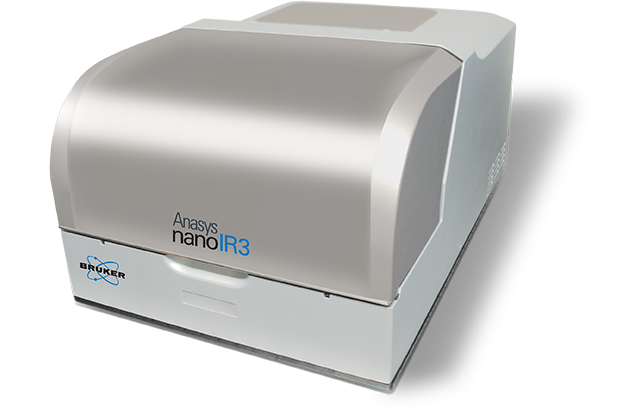Anasys nanoIR3
nanoIR3는 재료과학 및 생명과학 응용 분야에 적합한 최신 나노스케일 IR 분광법으로 화학적 이미지와 물질의 특성을 이미지 가능한 시스템입니다. 이 시스템은 IR 기반의 화학 이미징을 통해 측정 물질의 화학적 변화량을 매핑합니다. Point Spectroscopy 기능이 탑재되어 있어 분광법과 화학 이미징을 하나의 소스로 실행할 수 있습니다.
To learn more, continue reading, contact us, or see FAQs about this product.
완전한 나노스케일 특성화
nanoIR3는 나노스케일 특성화에 대한 종합적인 기능을 제공합니다. 유일한 POINTspectra 기능은 단일 레이저 소스로 점 분광 및 화학적 이미징을 종합적으로 제공하여 데이터에 도달하는 시간을 빠르게 하고, 궁극적으로 보다 비용 효율적인 연구 솔루션을 제공합니다. 초분광 이미징은 모르는 물질을 식별하고 추가적인 프로세싱을 전달 하기 위해 내부 표면의 3D 스펙트럼 맵을 생성할 수 있는 기능을 제공합니다.
고성능 단분자층 측정감도
브루커의 독자적인 공명을 이용한 AFM-IR 모드는 나노 단위의 물질을 식별하고 재료의 변화와 구성을 더 잘 이해할 수 있도록 도움을 주는 고성능의 풍부하고 고품질의 스펙트럼을 제공합니다. 얇은 필름에서 단분자층까지, 공명을 이용한 AFM-IR은 유기 물질의 나노스케일 분광학에서 가장 섬세한 기술입니다.
Tapping AFM-IR 화학적 이미징
독자적인 기술로 업계 최고의 AFM-IR 기기 개발을 구축한 Anasys nanoIR3는 고성능 나노스케일 IR 기술 입니다. Tapping AFM-IR 특허를 이용한 이미징 기술은 최고의 공간 해상도의 화학적 매핑을 생성하는 동시에 고품질 IR 분광법을 제공합니다. 고분자, 박막, 단분자층 또는 작고 얇은 오염물질의 화학적 구성 맵을 만드는 것 등, 어느 목적에 상관없이 Tapping AFM-IR 분광법, 화학적 이미징 및 오늘날 재료 및 생명과학 응용 분야에서 사용가능한 재료 속성 매핑 시스템을 통해 고해상도 화학 이미징을 쉽고 빠르게 얻을 수 있습니다.
nanoIR3 데이터 갤러리
Frequently Asked Questions
nanoIR3 offers photothermal AFM-IR with sub-10 nanometer chemical imaging, hyperspectral mapping, and direct FTIR-correlated spectra. It is ideal for routine small-sample analysis.
The nanoIR3 system supports Tapping AFM-IR and Resonance Enhanced AFM-IR as standard modes. Surface Sensitive AFM-IR is also available when the system is configured with compatible lasers and probes.
There is a configured version of the nanoIR3 offering AFM-IR measurements in liquid environments using bottom-up illumination. This is especially useful for biological and electrochemical applications.
nanoIR3 can be equipped with environmental enclosures for humidity and temperature control, heater/cooler units, and fluid imaging accessories. These options help tailor the system to your research needs.
More About Bruker's Nanoscale Infrared Technology
Yes. Bruker’s photothermal AFM-IR technology produces spectra that are directly comparable to FTIR spectra, as demonstrated in published documentation and peer-reviewed articles. AFM-IR spectra can be searched directly against FTIR spectral databases. If FTIR-like spectral analysis is critical for your application, our experts can provide evidence showing spectral correlation.
Photothermal AFM-IR provides direct absorption-based spectra that closely match FTIR results and are easier to interpret than Raman-AFM or s-SNOM. Further, Photothermal AFM-IR signals are amplified by the resonant enhancement of the cantilever providing the best signal-to-noise of those techniques. Bruker offers s-SNOM as a separate option for advanced near-field studies.
Bruker nanoIR systems routinely achieve chemical imaging with spatial resolution below 10 nm and can detect single molecular layers. Actual performance depends on your sample and selected measurement mode.
Yes, photothermal AFM-IR can chemically map and identify particles smaller than one micron, including nanoplastics and environmental contaminants. Direct correlation to FTIR provides ready interpretation in particles as small as 10 nm.
Bruker’s photothermal AFM-IR systems typically require a single socket of standard electrical power,and CDA. Specific requirements may vary by model, so request a site preparation guide from your Bruker representative.
Bruker photothermal AFM-IR systems primarily use quantum cascade lasers (QCLs) that deliver stable, reliable performance and broad coverage across the mid-infrared fingerprint region as well as optical parametric oscillators (OPOs) for the C-H, O-H, N-H stretching region. Multiple QCL chips can be combined to access all key spectral windows required for routine and advanced research, and additional sources are available for specialized applications. Bruker’s application experts can help you select the optimal laser configuration to match your measurement needs and ensure sufficient spectral resolution for both standard and demanding experiments.
Measurement times vary by application, but point spectra can be acquired in seconds, chemical maps in minutes, and automated recipes can be tailored for high-throughput workflows.
Routine maintenance includes probe replacement, laser alignment checks, and calibration with reference samples. Bruker provides detailed maintenance protocols and support plans.
